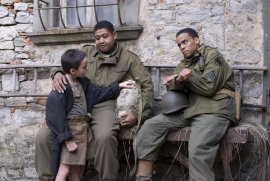 MIRACLE AT ST. ANNA
MIRACLE AT ST. ANNA
With credits including Do the Right Thing, Clockers, Get on the Bus, 4 Little Girls, 25th Hour, and the landmark documentary When the Levees Broke: A Requiem in Four Acts, Spike Lee has made more great films over the past 20 years, perhaps, than any other American director. (And that list doesn't include the Spike Lee joints that are merely very good, among them Jungle Fever, The Original Kings of Comedy, and Inside Man.) But when Lee's movies go wrong, they tend to go shockingly, stunningly wrong, and for at least its opening half hour, the director's new Miracle at St. Anna seems poised to topple Girl 6, Bamboozled, and the execrable Summer of Sam as the most misguided and embarrassing work of the director's career.
It doesn't happen, thank heavens, but that might only be because after the film's first 30 minutes, there are still more than 120 to go. (Talk about mixed blessings.) What we're finally left with in the World War II epic Miracle at St. Anna - directed by Lee, with screenwriter James McBride adapting his own novel - is about four or five different movies battling all for our (and Lee's) attention, and the overstuffed, borderline incoherent presentation turns out to be the one really interesting thing about it. Lee's latest is sprawling, messy, maddening, and frequently ridiculous, but I'll grant it one thing: It's never boring.
Not that boredom would've necessarily been less welcome than the hypnotic awfulness of the film's prelude. Although Miracle at St. Anna's ostensible focus concerns a platoon of Buffalo Soldiers in the 92nd Infantry - three African Americans (Derek Luke, Michael Ealy, and Omar Benson Miller) and a native Puerto Rican (Laz Alonso) - the movie opens in 1983, with an unconvincing framing device in which one of the GIs, from behind his bank teller's window, shoots a customer point-blank in the chest. The murder and its subsequent investigation are meant to set up a series of mysteries: What relationship did the former soldier have to his victim? What is the remnant of an Italian statue, worth some $4 million, doing hidden in the soldier's closet? What is the significance of "the sleeping man"?
Instead, though, Lee and McBride unwittingly inspire an entirely different set of questions. What New York bank, even in the early '80s, would allow its tellers such easy access to loaded weapons? Why are the city's gumshoes and reporters speaking in the wise-guy cadences of a James Cagney movie, and why is their dialogue (and delivery) so terrible? What's with the distracting cameos by John Leguizamo and Spike Lee stock player John Turturro? And sadly, Miracle at St. Anna doesn't get any more engaging once the setting shifts to 1944 Europe; despite a viscera-strewn skirmish, the images lack power, the conversation doesn't sound remotely of the period, and you might feel a thudding in your temple when Miller's saintly, lumbering man-child befriends, and consequently serves as protector for, an Italian waif (Matteo Sciabordi) who calls him "the chocolate giant." Oh, the preciousness! Oh, the maudlin excess!
Events substantially improve, however, with the squadron's arrival in Tuscany, mainly because Miracle at St. Anna then turns into an entirely different movie (or two or three). Once the film begins exploring the rivalries and fragile kinships that develop between, and among, the Americans and their Italian allies, its director seems on more solid ground, and a number of sequences have the sort of electricity and snap we traditionally expect from Lee: the battles of will between the stalwart Luke and the contemptuous Ealy; a racially charged trek to a Southern café (a flashback within a flashback); a horrific massacre at a rustic church; a moving tableau as the soldiers stare at a wall covered in anti-American (specifically anti-black) propaganda; a devastating Nazi attack on a Tuscan village. While McBride's script remains overwritten and rather obvious throughout - and hits a nadir in the movie's final, unbelievably contrived minutes - Lee manages to lend some vigor and grace to the hodgepodge material.
Yet Miracle at St. Anna remains a bum experience - always watchable, but rarely memorable. It's taken Hollywood more than 60 years to devote a film to the African-American soldiers who served in World War II, and at the end of Lee's latest, you're still kind of waiting for one; the movie is so overflowing with narrative detours and tangents and meaningless symbolism (that lugged-about piece of marble statue is certainly one of the most cumbersome red herrings in modern cinema) that its entire reason for being gets lost. One can only hope that Miracle at St. Anna is the beginning of a genre cycle and not its dispiriting end.










